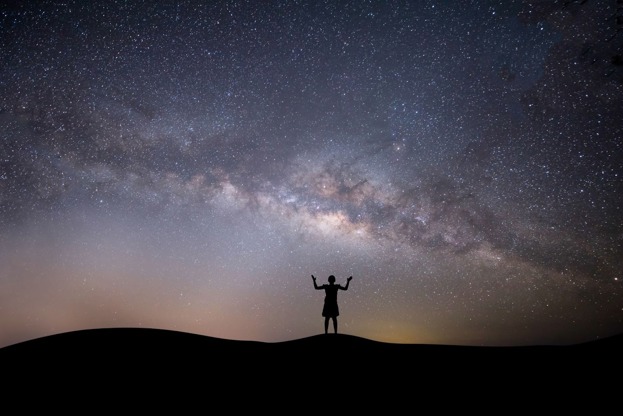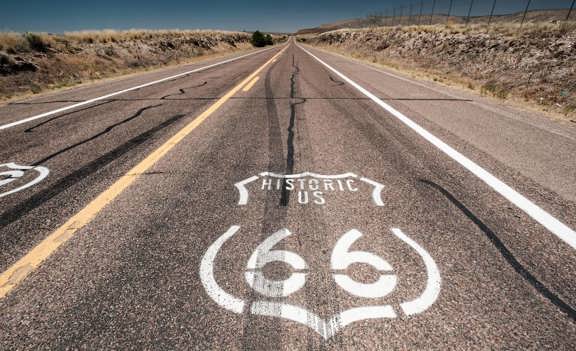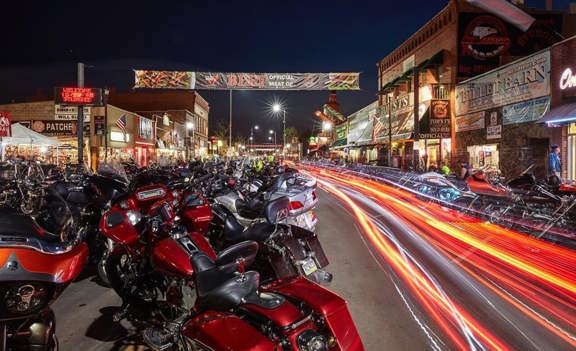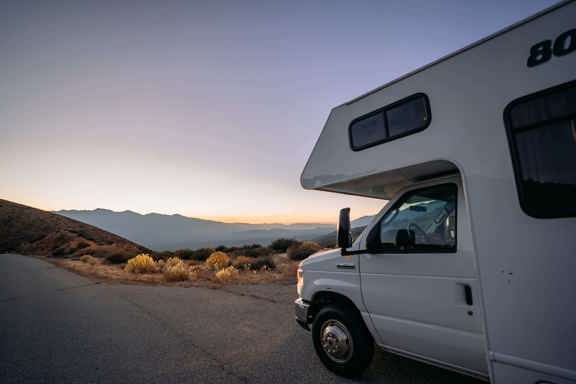
The 20 Best Noctourism Destinations to Visit
- RV Lifestyle
- Family Friendly
- Road Trip
- get inspired

Noctourism is a growing travel trend defined by exploring destinations after the sun sets, when the world transforms into something quieter, deeper, and often more magical. Instead of packing every activity into daylight hours, travelers intentionally seek nighttime experiences—from wandering vibrant night markets to watching the night sky ignite with stars. Over the past year, interest in nocturnal travel has surged as more people crave unique experiences that feel immersive, grounding, and different from the typical vacation routine.
Unlike traditional tourism, noctourism focuses on how places look, sound, and feel under moonlight or glowing city lights, emphasizing wonder, stillness, and connection to natural phenomena. It includes everything from night safaris and night diving to architecture tours and stargazing sessions in dark sky parks where light pollution is minimal.
Many travelers say these adventures feel more intimate and awe-inspiring—an opportunity to witness nocturnal animals in their natural habitat, observe rare natural phenomena, or simply enjoy slower moments of reflection while star bathing beneath the Milky Way.
Publications like National Geographic have highlighted noctourism as a huge driver in how people choose their next trip, especially as destinations invest more in safe, guided nighttime tours. With two-thirds of the world’s population unable to see the stars clearly due to light pollution, the growing appeal of dark, quiet spaces makes complete sense. Noctourism invites travelers to step into a different rhythm—one that’s quieter, cooler, and filled with unforgettable sights that only appear at night.
Why the Night Sky Is Inspiring More Travelers Than Ever

More travelers are planning trips around the night sky, seeking moments of wonder that feel increasingly rare in a world filled with constant noise and light pollution. Whether it’s watching the Milky Way stretch across a perfectly dark horizon or witnessing the swirling colors of the northern lights, nocturnal travel speaks to a desire for stillness, awe, and a deeper connection to nature.
Part of the surge comes from the rise of dark sky parks and protected reserves designed to preserve natural darkness. These destinations make stargazing trips safer, easier, and more accessible for visitors who want to see the stars the way ancient travelers once did. Many resorts now even include night-focused experiences—like guided constellation walks, “star bathing” sessions, or hot tub decks built for sky watching—as a way to help guests slow down and reconnect with the world above them.
The fascination also ties into the growing appeal of witnessing natural phenomena that only appear at night. The aurora borealis, glowing bioluminescent bays, and meteor showers all offer unforgettable scenes that can’t be captured during daylight hours. And with platforms and news outlets featuring these experiences, travelers are putting them higher up on their bucket lists.
As more destinations combat light pollution and invest in night-friendly infrastructure, noctourism continues to grow. For many travelers, it’s not just about seeing the sky — it’s about escaping the routine, leaning into quiet, and letting the night become its own kind of adventure.
The 20 Best Noctourism Destinations in the U.S. & Canada

From glowing bioluminescent bays to some of the darkest skies on Earth, North America offers world-class noctourism experiences. These destinations invite travelers to step outside after sunset and discover a completely different side of nature, culture, and adventure.
1. Fairbanks, Alaska — America’s Northern Lights Capital
Fairbanks lies directly under the auroral oval, giving travelers some of the best aurora borealis viewing opportunities in the Northern Hemisphere.
Why it’s perfect: Clear winter skies, low humidity, and minimal light pollution.
Look for:
-
Intense green and purple auroras
-
Orion, Cassiopeia, and the winter Milky Way
-
January’s Quadrantid meteor shower
2. Denali National Park, Alaska — Wide-Open Arctic Night Skies
Denali’s untouched wilderness offers some of the darkest skies in the United States.
Why it’s perfect: Long winter nights and huge expanses of wilderness create ideal stargazing conditions.
Look for:
-
The Milky Way arching over North America’s tallest peak
-
Northern lights reflected in snowfields
3. Banff National Park, Alberta — Canada’s Premier Dark Sky Preserve
Banff’s high elevation and crisp air make it one of the most spectacular stargazing destinations in Canada.
Why it’s perfect: The annual Banff Dark Sky Festival draws astronomers from around the world.
Look for:
-
The Andromeda Galaxy
-
Stunning Milky Way views over Lake Minnewanka
4. Jasper National Park, Alberta — One of the World’s Largest Dark Sky Reserves
Jasper is internationally recognized for its pristine night conditions.
Why it’s perfect: Extremely low light pollution and accessible viewpoints.
Look for:
-
Shooting stars during the Perseids
-
The glowing band of the Milky Way
5. Big Bend National Park, Texas — One of the Darkest Skies in the Lower 48
Big Bend is officially the darkest national park in the contiguous United States.
Why it’s perfect: Dry desert climate + remote location = crystal-clear skies.
Look for:
-
Thousands of visible stars
-
Nocturnal animals like foxes, owls, and javelinas
6. Acadia National Park, Maine — New England’s Night Sky Haven
Acadia offers stunning coastal stargazing along the Atlantic.
Why it’s perfect: The Acadia Night Sky Festival celebrates astronomy each fall.
Look for:
-
Milky Way views over ocean cliffs
-
Bright summer constellations like Cygnus and Lyra
7. Bryce Canyon National Park, Utah — Hoodoos Under the Stars
One of the best dark-sky parks in the country, Bryce Canyon shines after sunset.
Why it’s perfect: Ranger-led constellation tours and ultra-clear air.
Look for:
-
Milky Way framed by rock spires
-
Deep-sky objects visible with the naked eye
8. Joshua Tree National Park, California — Cosmic Desert Vistas
Joshua Tree’s alien landscape becomes even more surreal at night.
Why it’s perfect: Low humidity and high elevation.
Look for:
-
The galactic core in summer
-
Famous meteor showers like the Leonids and Geminids
9. Death Valley National Park, California/Nevada — A Gold-Tier Dark Sky Park
Death Valley is one of the darkest places on Earth officially recognized by the International Dark-Sky Association.
Why it’s perfect: Zero humidity and massive open spaces.
Look for:
-
The clearest Milky Way views in North America
-
Bright planetary alignments
10. Cherry Springs State Park, Pennsylvania — East Coast’s Darkest Sky
A top stargazing spot accessible to major cities like NYC and Washington DC.
Why it’s perfect: Designated as a Gold Level Dark Sky Park.
Look for:
-
Naked-eye visibility of the Milky Way
-
The bright dust lanes of the galactic core
11. Sedona, Arizona — Dark Skies + Energy Vortexes
Sedona blends stargazing with spiritual nighttime experiences.
Why it’s perfect: Clear skies and nighttime “star bathing” tours.
Look for:
-
Milky Way arches over red rock formations
-
Famous constellations like Scorpius
12. Great Basin National Park, Nevada — High-Elevation Stargazing
Remote and mountainous, Great Basin has nearly zero light pollution.
Why it’s perfect: Great Basin Astronomy Festival + 13,000-foot Wheeler Peak.
Look for:
-
Thousands of stars visible without a telescope
-
Meteor showers with excellent visibility
13. Montréal, Québec — Night Architecture & Cultural Noctourism
Montréal offers a mix of city nightlife and artistic light displays.
Why it’s perfect: Year-round nighttime festivals.
Look for:
-
The interactive “Cité Mémoire” projection displays
-
Illuminated historical buildings
14. New York City, New York — Iconic Urban Nightscapes
Urban noctourism thrives in NYC’s glowing skyline.
Why it’s perfect: Endless nighttime tours and late-night food markets.
Look for:
-
Manhattan skyline views from Brooklyn
-
Reflective moonlight over the Hudson
15. Tromsø-Inspired Experience: Northern Canada’s Yukon Territory
Whitehorse and the Yukon wilderness offer exceptional aurora visibility.
Why it’s perfect: High latitude + remote wilderness.
Look for:
-
Bright aurora coronas
-
Winter constellations surrounded by snowfields
16. Hawai‘i (Big Island) — Night Diving with Manta Rays
A legendary noctourism experience.
Why it’s perfect: Underwater lights draw manta rays to feed.
Look for:
-
Graceful manta rays swirling overhead
-
Bioluminescent water particles
17. Great Sand Dunes National Park, Colorado — Night at the Dunes
The tallest sand dunes in North America offer massive open-sky views.
Why it’s perfect: Ultra-clear air and elevation.
Look for:
-
Milky Way glowing above dune ridges
-
Summer meteor showers
18. Québec’s Charlevoix Region — Nighttime Forest & Wildlife Encounters
Charlevoix excels at quiet nature-based noctourism.
Why it’s perfect: Limited development = excellent stargazing.
Look for:
-
The Milky Way reflected off the lakes
-
Nocturnal forest animals
19. Outer Banks, North Carolina — Stellar Coastal Viewing
The OBX has wide beaches perfect for night walks and stargazing.
Why it’s perfect: Very low light pollution for the East Coast.
Look for:
-
Dark, clear horizons
-
Seasonal bioluminescence in shallow waters
20. Glacier National Park, Montana — Mountain Skies + Moonlit Peaks
With towering mountains and limited artificial light, Glacier offers breathtaking nighttime vistas.
Why it’s perfect: High altitude + remote wilderness.
Look for:
-
Starry skies reflected in alpine lakes
-
Dark, crisp winter nighttime views
How to Plan Your First Noctourism Trip

Nighttime travel experiences can be magical, but they also require a bit of planning to make sure you’re safe, comfortable, and in the right place at the right time. Noctourism is about slowing down, embracing the dark, and letting the world reveal itself in new ways — and with a few simple steps, you can craft a nighttime adventure that feels effortless and immersive.
Check Moon Phases & Seasonal Conditions
Your noctourism experience can look completely different depending on the moon cycle.
-
New moon: Best for stargazing, Milky Way visibility, and dark sky photography.
-
Full moon: Ideal for moonlit hikes, night paddling, and nighttime landscapes.
For aurora viewing, research peak months (usually winter in northern regions) and aim for cold, clear nights with minimal cloud cover.
Choose Destinations with Low Light Pollution
Use tools like:
-
DarkSky.org maps
-
LightPollutionMap.info
-
National Park Service sky quality reports
Even an hour outside a major city can transform your night sky experience.
Prepare for Nighttime Safety
Bring:
-
Headlamps with red-light mode
-
Warm layers (temperatures drop fast at night)
-
A thermos of hot tea or cocoa
-
Bug spray when visiting warm or coastal destinations
-
Backup batteries for cameras and phones
Always tell someone where you’re going and stay aware of your surroundings — especially in wildlife-heavy areas.
Consider an RV for Comfort & Convenience
Noctourism pairs beautifully with RV travel because it offers:
-
A warm, private place to rest between nighttime outings
-
Onboard cooking for late-night snacks or post-adventure meals
-
Extra storage for telescopes, cameras, boots, and layers
-
The ability to chase clear skies or move to a better viewing area in minutes
With an RV, you can stay directly inside or next to many dark sky destinations — without driving long distances at night.
Take Advantage of Guided Night Tours
If you’re new to nocturnal adventures, guided experiences are a great introduction. Many national parks, observatories, and wildlife centers offer:
-
Ranger-led constellation programs
-
Astronomy nights with telescopes
-
Nighttime animal walks
-
Bioluminescent kayak tours
-
Night diving or night hiking
These are perfect for families, beginners, or anyone who wants expert insights.
Why RV Travel Is Perfect for Noctourism

Noctourism is all about embracing the world after dark — and no form of travel supports that better than an RV. Whether you're chasing the northern lights, stargazing in remote deserts, or joining guided nighttime safaris in protected parks, an RV gives you the freedom, comfort, and mobility to make the most of every nighttime moment.
Stay Overnight in Prime Viewing Spots
Some of the best noctourism locations are far from major cities, hotels, and amenities. With an RV, you can stay:
-
Right inside national parks with dark sky access
-
Along coastal overlooks perfect for moonlit ocean watching
-
In mountain passes ideal for meteor showers
-
Near designated dark sky parks without needing late-night driving
Instead of packing up and heading back to town, your home base is already waiting.
Avoid Dangerous Late-Night Drives
Exploring after sunset often means long, winding, or wildlife-heavy roads. RV travel eliminates the need to:
-
Drive home tired after hours of nighttime activity
-
Search for last-minute lodging after stargazing or aurora chasing
You can simply return to your RV, cook a warm meal, and go straight to sleep.
Enjoy the Comforts of Home Between Adventures
Noctourism often involves waiting — waiting for the moon to set, the clouds to clear, or the aurora to appear. With an RV, downtime becomes part of the experience. You can:
-
Warm up inside
-
Brew coffee or hot chocolate
-
Charge your cameras and phones
-
Review your night photography
-
Rest in a real bed before heading out for round two
This makes late-night activities far more enjoyable for families, couples, and solo travelers.
Ideal for Stargazers, Photographers, and Aurora Chasers
Nighttime adventurers often bring bulky gear, such as:
-
Tripods
-
DSLR cameras
-
Star trackers
-
Telescopes or binoculars
-
Extra lenses and batteries
RVs provide generous storage and safe transport for delicate equipment — something rental cars and hotel rooms can’t always guarantee.
The Freedom to Chase Clear Skies
Weather changes quickly, especially in northern or coastal regions. An RV gives you the mobility to pivot instantly:
-
If clouds roll in
-
If smoke affects visibility
-
If forecasts predict aurora activity in another town
-
If park rangers recommend a different vantage point
You’re never tied to a single destination — your entire trip is flexible and sky-dependent.
A Low-Light Haven for Unwinding
After a night of activity, there’s nothing better than stepping inside a cozy, softly lit space. You control your environment:
-
Quiet, warm, and dark for sleep
-
A place to read or journal about the night
-
A private spot to watch the stars through a window
-
A peaceful base for meditation or reflection
For wellness-minded travelers, nighttime RV stays become part of the restorative experience.
Popular Constellations & Planets You Can See — and How to Find Them

One of the most rewarding parts of noctourism is discovering the night sky in a deeper, more intentional way. Whether you’re stargazing in a Dark Sky Park, parked in a quiet RV campsite, or scanning the horizon during a northern lights chase, knowing what to look for can turn an ordinary evening into an unforgettable celestial show.
Below are some of the most popular constellations and planets visible throughout the United States and Canada — plus simple tips for spotting each one.
The Big Dipper (Ursa Major)
Why it’s popular: It’s one of the easiest star patterns to identify and often the first constellation beginners learn.
How to find it:
-
Look north.
-
Find a large “ladle” shape with a long handle.
-
Use the two outer bowl stars (“pointer stars”) to find Polaris, the North Star.
Best viewing: Spring and early summer evenings, though visible year-round.
The North Star (Polaris)
Why it’s special: Polaris marks true north and is a major navigation star for campers and stargazers.
How to find it:
-
Locate the Big Dipper.
-
Follow the pointer stars upward to a moderately bright star — that’s Polaris.
Best viewing: Clear northern skies, away from city light.
Orion the Hunter
Why it’s popular: Bright, easy to recognize, and full of deep-sky objects like the Orion Nebula.
How to find it:
-
Look for three perfectly lined-up stars — Orion’s Belt.
-
Two bright stars above (Betelgeuse and Bellatrix) and two bright stars below (Rigel and Saiph) form a rectangle.
Best viewing: Winter and early spring.
Cassiopeia
Why it’s popular: Its unique “W” shape is easy to spot.
How to find it:
-
Look northeast.
-
Find the distinct zigzag “W” made of five bright stars.
Best viewing: Fall and winter.
The Milky Way
Why it’s a bucket-list sight: A glowing band of light stretching across the sky — our own galaxy seen edge-on.
How to find it:
-
Look for a misty, cloud-like river of light arching across the sky.
-
Best viewed from Dark Sky areas with minimal light pollution.
Best viewing: Summer and early fall.
Planets You Can See Without a Telescope
Mars
-
Reddish and steady — unlike twinkling stars.
-
Appears brightest every two years during opposition.
-
Look east in early evening or west before sunrise.
Saturn
-
Yellow-white glow.
-
Appears near the constellation Aquarius or Capricornus depending on the year.
-
Best seen in late summer and fall.
Jupiter
-
One of the brightest objects in the sky.
-
Often mistaken for a plane until its steady light gives it away.
-
Use binoculars to see its four largest moons.
Venus (The Evening or Morning Star)
-
The brightest planet — visible right after sunset or right before sunrise.
-
Often sits low near the horizon.
Simple Tips for Finding Constellations & Planets
Use a stargazing app
Apps like SkyView, Stellarium, Night Sky, and Star Walk use augmented reality to help you identify stars by pointing your phone at the sky.
Let your eyes adjust
It takes 20–30 minutes for your eyes to fully see dim stars. Avoid bright lights during this time.
Look for a dark horizon
Mountains, trees, or RV park lights can block major constellations or planets if they sit too low.
Use red light instead of white
Red light preserves night vision and helps you continue stargazing comfortably.
Bring binoculars
Even a basic pair (7x50 or 10x50) reveals star clusters, planets, and nebulae.
Ready to Experience the Night Like Never Before?
Noctourism offers a whole new way to explore the world after dark — and an RV gives you the freedom to chase every stargazing moment, midnight hike, or northern lights sighting at your own pace. If you’re ready to turn your next trip into an unforgettable nighttime adventure, rent an RV from Cruise America and hit the road tonight.





